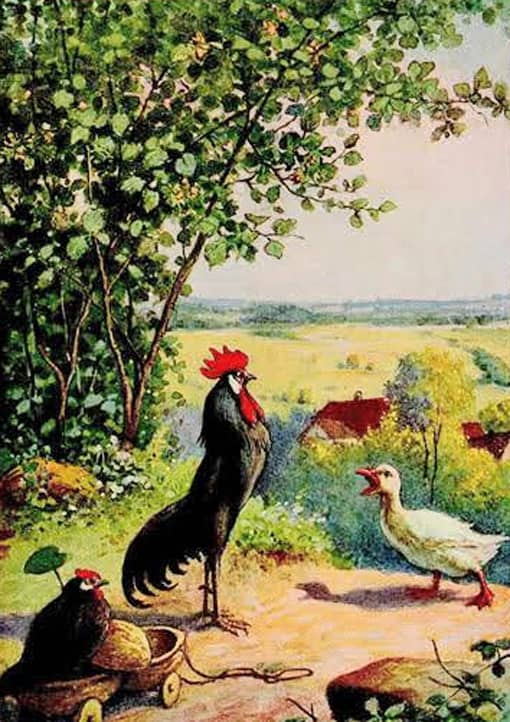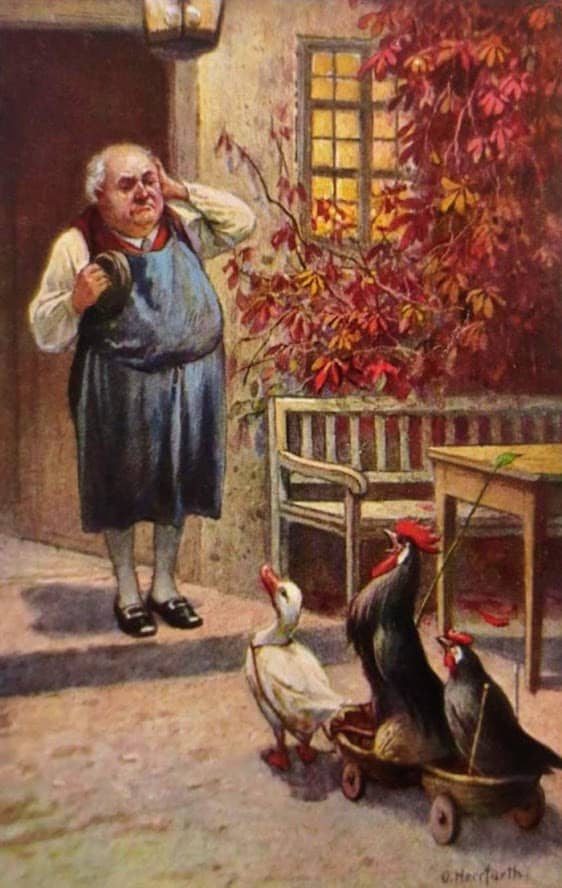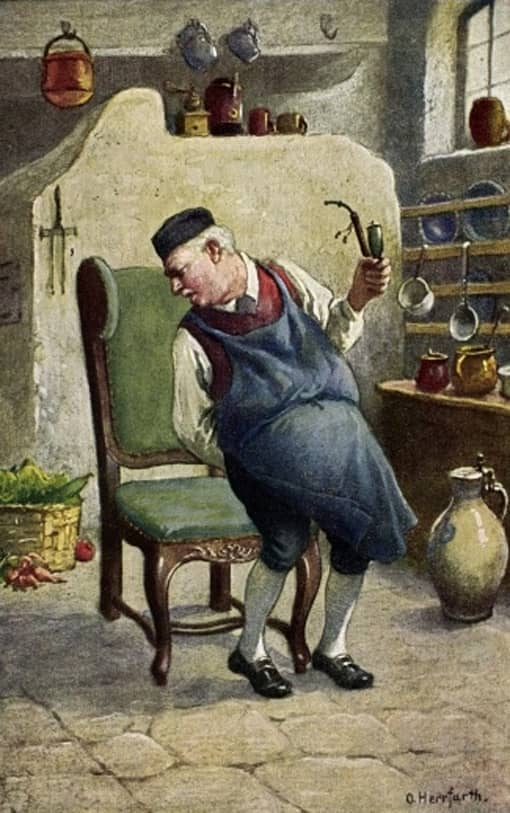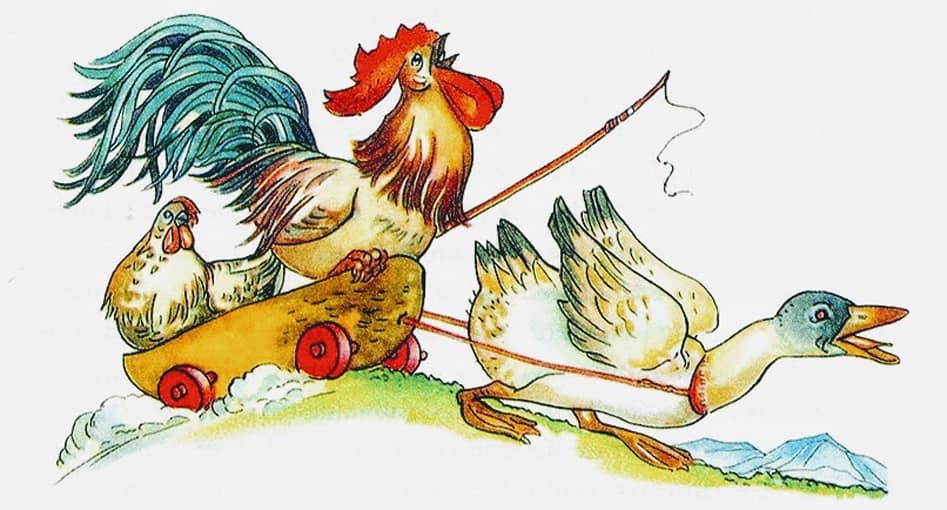Reading time: 7 min
The cock once said to the hen, „It is now the time when our nuts are ripe, so let us go to the hill together and for once eat our fill before the squirrel takes them all away.“ – „Yes,“ replied the hen, „come, we will have some pleasure together.“ Then they went away to the hill, and on it was a bright day they stayed till evening.
Now I do not know whether it was that they had eaten till they were too fat, or whether they had become proud, but they would not go home on foot, and the cock had to build a little carriage of nut-shells. When it was ready, the little hen seated herself in it and said to the cock, „Thou canst just harness thyself to it.“ – „I like that!“ said the cock, „I would rather go home on foot than let myself be harnessed to it. No, that is not our bargain. I do not mind being coachman and sitting on the box, but drag it myself I will not.“
 Image: Oskar Herrfurth (1862-1934)
Image: Oskar Herrfurth (1862-1934)As they were thus disputing, a duck quacked to them, „You thieving folks, who bade you go to my nut-hill? Well, you shall suffer for it!“ and ran with open beak at the cock. But the cock also was not idle, and fell boldly on the duck, and at last wounded her so with his spurs that she also begged for mercy, and willingly let herself be harnessed to the carriage as a punishment. The little cock now seated himself on the box and was coachman, and thereupon they went off in a gallop, with „Duck, go as fast as thou canst.“ When they had driven a part of the way they met two foot-passengers, a pin and a needle.
They cried, „Stop! stop!“ and said that it would soon be as dark as pitch, and then they could not go a step further, and that it was so dirty on the road, and asked if they could not get into the carriage for a while. They had been at the tailor’s public- house by the gate, and had stayed too long over the beer. As they were thin people, who did not take up much room, the cock let them both get in, but they had to promise him and his little hen not to step on their feet. Late in the evening they came to an inn, and as they did not like to go further by night, and as the duck also was not strong on her feet, and fell from one side to the other, they went in.
 Image: Oskar Herrfurth (1862-1934)
Image: Oskar Herrfurth (1862-1934)The host at first made many objections, his house was already full, besides he thought they could not be very distinguished persons; but at last, as they made pleasant speeches, and told him that he should have the egg which the little hen has laid on the way, and should likewise keep the duck, which laid one every day, he at length said that they might stay the night. And now they had themselves well served, and feasted and rioted.
Early in the morning, when day was breaking, and every one was asleep, the cock awoke the hen, brought the egg, pecked it open, and they ate it together, but they threw the shell on the hearth. Then they went to the needle which was still asleep, took it by the head and stuck it into the cushion of the landlord’s chair, and put the pin in his towel, and at the last without more ado they flew away over the heath.
The duck who liked to sleep in the open air and had stayed in the yard, heard them going away, made herself merry and found a stream, down which she swam, which was a much quicker way of travelling than being harnessed to a carriage. The host did not get out of bed for two hours after this. He washed himself and wanted to dry himself, then the pin went over his face and made a red streak from one ear to the other. After this he went into the kitchen and wanted to light a pipe, but when he came to the hearth the egg-shell darted into his eyes.
 Image: Oskar Herrfurth (1862-1934)
Image: Oskar Herrfurth (1862-1934)„This morning everything attacks my head, “ said he, and angrily sat down on his grandfather’s chair, but he quickly started up again and cried, „Woe is me, “ for the needle had pricked him still worse than the pin, and not in the head. Now he was thoroughly angry, and suspected the guests who had come so late the night before, and when he went and looked about for them, they were gone. Then he made a vow to take no more ragamuffins into his house, for they consume much, pay for nothing, and play mischievous tricks into the bargain by way of gratitude.
 Learn languages. Double-tap on a word.Learn languages in context with Childstories.org and Deepl.com.
Learn languages. Double-tap on a word.Learn languages in context with Childstories.org and Deepl.com.Backgrounds
Interpretations
Adaptions
Summary
Linguistics
„The Pack of Ragamuffins“ is a lesser-known fairy tale collected by the Brothers Grimm in their 1812 publication „Children’s and Household Tales“ (also known as „Grimm’s Fairy Tales“). The story, sometimes referred to as „The Adventures of Chanticleer and Partlet“ or „The Cock and the Hen,“ is a humorous animal tale that features a series of comical and unfortunate events.
The Brothers Grimm, Jacob and Wilhelm, were German scholars, linguists, and cultural researchers who are best known for their work in compiling and preserving a vast collection of European folktales during the early 19th century. Their goal was to capture the oral traditions and folklore of their time before they were lost. The Brothers Grimm collected stories from various sources, including the oral storytelling traditions of rural communities, written texts, and the works of other collectors. They transcribed, edited, and rewrote these tales to create a comprehensive collection that has become a staple of Western literature.
„The Pack of Ragamuffins“ is one of over 200 stories collected by the Brothers Grimm, and it is considered a lesser-known tale compared to their more famous works, such as „Cinderella,“ „Snow White,“ „Rapunzel,“ and „Hansel and Gretel.“ The story’s themes and motifs, such as talking animals, greed, and trickery, are common in many other fairy tales and folktales from around the world. As with most fairy tales, „The Pack of Ragamuffins“ has been adapted and retold in various forms over the years, including illustrations, theatrical productions, and modern reinterpretations. The story continues to be enjoyed by readers and audiences today for its whimsical characters, moral lessons, and entertaining narrative.
This tale stands out from other Grimm fairy tales due to its lighter, more humorous tone, and the use of animal characters. It is similar to other animal tales and fables that often contain moral lessons or satirical elements. The backgrounds to this story can be traced to European oral tradition, which includes various folktales and fables involving animals. While „The Pack of Ragamuffins“ may not be as famous as some other Grimm fairy tales, it remains an entertaining and engaging story. The Brothers Grimm’s collection of such tales aimed to preserve German folklore and culture, and „The Pack of Ragamuffins“ is an example of the diversity and richness of these traditional narratives.
„The Pack of Ragamuffins“ is a lighthearted and humorous tale, which stands in contrast to many of the darker, more moralistic stories in the Brothers Grimm collection. While the story may not have a single, clear moral lesson, there are several interpretations that can be drawn from the tale:
The Consequences of Greed and Laziness: The story shows the cock and hen’s unwillingness to walk home after indulging themselves, leading them to create a makeshift carriage and enlist the help of other characters. Their behavior can be seen as a cautionary tale against greed and laziness, which often lead to negative consequences for oneself and others.
Unlikely Alliances: The tale demonstrates how characters from different backgrounds (a cock, a hen, a duck, a pin, and a needle) come together and form an alliance. Though their partnership may be unconventional, it works for them in their journey, highlighting the idea that sometimes unexpected alliances can be beneficial.
The Importance of Hospitality: The story also touches upon the theme of hospitality, as the innkeeper initially hesitates to offer shelter to the group of ragamuffins but eventually agrees. However, the characters take advantage of his hospitality, which leads him to become wary of similar guests in the future. This can be interpreted as a reminder to treat hosts with respect and gratitude.
The Consequences of Deception and Mischief: The cock and hen’s decision to play tricks on the innkeeper results in negative consequences for him. This can serve as a warning against engaging in deceitful or mischievous behavior, as it can lead to negative outcomes for both the perpetrators and the victims.
Resourcefulness and Adaptability: Throughout the story, the characters demonstrate their ability to adapt to different situations and use their resources to solve problems. The cock builds a carriage from nutshells, and the group manages to negotiate their way into the inn. This theme highlights the importance of being resourceful and adaptable in life.
The importance of cooperation and friendship: Throughout their journey, the animal characters work together and support each other despite their differences. This can be seen as an illustration of the value of cooperation and the strength that can be found in unity.
The consequences of deception: The story features a series of tricks and deceptions, particularly when the group deceives the innkeeper. While the tale is primarily humorous, it also serves as a reminder that dishonesty can lead to negative consequences, as seen by the innkeeper’s anger and desire for revenge.
Satire on human behavior: The animals in the story exhibit human-like traits and behaviors, such as greed and dishonesty. This can be interpreted as a satirical commentary on human nature, suggesting that the animal characters represent human vices and weaknesses.
The absurdity of life: The story’s episodic structure, in which the characters encounter a series of increasingly absurd situations, can be seen as a reflection of the unpredictability and absurdity of life. The humor and light-heartedness of the story serve to highlight the chaotic and often nonsensical nature of the world.
Folklore and oral tradition: As a part of the Brothers Grimm collection, „The Pack of Ragamuffins“ showcases the richness and diversity of European folktales and oral tradition. The story can be seen as a representation of the imaginative and creative aspects of storytelling that have been passed down through generations.
While „The Pack of Ragamuffins“ may not have a single, unifying interpretation or moral lesson, it offers readers a light-hearted and entertaining narrative that can be appreciated for its humor, charm, and insight into the oral storytelling traditions of Europe. Overall, „The Pack of Ragamuffins“ offers a variety of interpretations and life lessons, including the consequences of greed, laziness, and deception, the importance of hospitality, and the value of resourcefulness and adaptability.
„The Pack of Ragamuffins“ is not as widely adapted as other Grimm fairy tales, but it has still inspired some adaptations and references in various media:
Books and retellings: „Grimm’s Fairy Tales“ (1982) by Lisbeth Zwerger: This illustrated book contains a retelling of „The Pack of Ragamuffins“ along with other selected stories from the Brothers Grimm. Zwerger’s illustrations provide a fresh and charming visual interpretation of the tale. „The Grimm Brothers‘ Children’s and Household Tales“ (2014) by Jack Zipes: This comprehensive collection of the Brothers Grimm fairy tales includes „The Pack of Ragamuffins“ and offers a faithful retelling of the original story, along with annotations and background information.
Animated television adaptations: „Grimm’s Fairy Tale Classics“ (1987-1989): This Japanese animated series, known as „Grimm Masterpiece Theater“ in Japan, adapted many Brothers Grimm fairy tales, including „The Pack of Ragamuffins.“ The series retells the story in a family-friendly format, maintaining the humor and charm of the original tale.
Theater and puppet shows: Some smaller theater companies, puppet theaters, and storytelling groups have performed adaptations of „The Pack of Ragamuffins,“ especially in children’s theater settings. These performances often focus on the humor and lightheartedness of the story, making it accessible and engaging for young audiences.
While „The Pack of Ragamuffins“ may not have the same level of adaptations and retellings as some of the more famous Grimm fairy tales, it remains an entertaining and humorous story that can be enjoyed by audiences of all ages. These are just a few examples of the many adaptations of „The Pack of Ragamuffins“ that have been created over the years. The tale’s enduring popularity and universal themes continue to inspire new adaptations and retellings in various forms of media.
„The Pack of Ragamuffins“ is a fairy tale by the Brothers Grimm that tells the story of a cock and hen who decide to go to a hill to eat their fill of nuts before squirrels take them all. After eating, they refuse to walk back home, so the cock builds a carriage made of nutshells. They argue about who should pull the carriage, and a duck intervenes, accusing them of stealing nuts from her hill. After a fight, the duck submits and is harnessed to the carriage.
On their way, they encounter a pin and a needle who ask for a ride, as it is getting dark and they have been drinking at the tailor’s public house. The cock agrees, but only if they promise not to step on him and the hen. They eventually reach an inn, where the innkeeper reluctantly allows them to stay the night in exchange for the eggs laid by the hen and the duck.
The next morning, before anyone else wakes up, the cock and hen eat an egg, discard the shell on the hearth, and play tricks on the innkeeper by placing the needle in his chair cushion and the pin in his towel. They then fly away, while the duck swims down a stream to travel more quickly. When the innkeeper finally wakes up, he is pricked by the pin and needle and gets eggshell in his eyes. Furious, he vows never to allow ragamuffins into his inn again, as they consume much, pay nothing, and play mischievous tricks as a form of gratitude.
The fairy tale „The Pack of Ragamuffins“ by the Brothers Grimm presents a whimsical narrative filled with animal characters and anthropomorphism. Linguistically, the tale employs several traditional storytelling techniques characteristic of folktales and fairy tales. Here is an analysis of some of the linguistic and stylistic elements found in the story:
Dialogue and Direct Speech: The story uses dialogue to build character and advance the plot. For example, the characters communicate directly with each other, such as the conversation between the cock and the hen at the beginning and the confrontation with the duck. This use of dialogue introduces immediacy and character personality.
Anthropomorphism: The cock, hen, and duck are imbued with human characteristics. They communicate, argue, and make decisions like humans, reflecting the common fairy tale trope of talking animals. This anthropomorphism makes the animals relatable to the reader, offering moral and social commentary in a playful manner.
Moral and Social Commentary: The story satirizes social behavior and norms through the actions and decisions of the characters. The cock and hen’s reluctance to walk home, preferring a carriage made of nutshells, suggests themes of pride and laziness. The tale critiques the behavior of those who exploit hospitality and engage in mischievousness, as seen in the host’s promise to never accommodate ragamuffins again.
Humor and Irony: There is an underlying layer of humor and irony throughout the story. The idea of a duck, cock, and hen traveling together in a nutshell-carriage is inherently absurd and amusing. The tale’s conclusion, where the host suffers from the guests‘ mischievousness despite accommodating them in his inn, reinforces this humorous tone.
Repetitive and Patterned Structure: Typical of Grimm’s tales, the story has a patterned structure with repetition that aids memorability. Phrases are often reused, which is characteristic of oral storytelling tradition, making stories easier to remember and retell.
Narrative Voice and Style: The narrative employs a straightforward, omniscient voice, common in fairy tales, that presents events in a sequential and logical order. The narrator’s tone is matter-of-fact, allowing the absurdities of the situations to speak for themselves and emphasizing the tale’s moral.
Use of Imagery and Descriptive Language: Although the tale is succinct, it includes vivid imagery, such as the „red streak from one ear to the other“ and the „egg-shell darted into his eyes,“ which enhances the physical comedy of the events described.
Overall, „The Pack of Ragamuffins“ uses these linguistic elements to create a captivating story that entertains while offering commentary on human nature and social behaviors, encapsulated within a fantastical narrative framework.
Information for scientific analysis
Fairy tale statistics | Value |
|---|---|
| Number | KHM 10 |
| Aarne-Thompson-Uther-Index | ATU Typ 210 |
| Translations | DE, EN, DA, ES, FR, PT, FI, HU, IT, JA, NL, PL, RU, TR, VI, ZH |
| Readability Index by Björnsson | 35 |
| Flesch-Reading-Ease Index | 77.6 |
| Flesch–Kincaid Grade-Level | 8.8 |
| Gunning Fog Index | 11.7 |
| Coleman–Liau Index | 7 |
| SMOG Index | 8.9 |
| Automated Readability Index | 9.5 |
| Character Count | 4.158 |
| Letter Count | 3.159 |
| Sentence Count | 32 |
| Word Count | 817 |
| Average Words per Sentence | 25,53 |
| Words with more than 6 letters | 77 |
| Percentage of long words | 9.4% |
| Number of Syllables | 998 |
| Average Syllables per Word | 1,22 |
| Words with three Syllables | 31 |
| Percentage Words with three Syllables | 3.8% |

 Facebook
Facebook  Whatsapp
Whatsapp  Messenger
Messenger  Telegram
Telegram Reddit
Reddit















